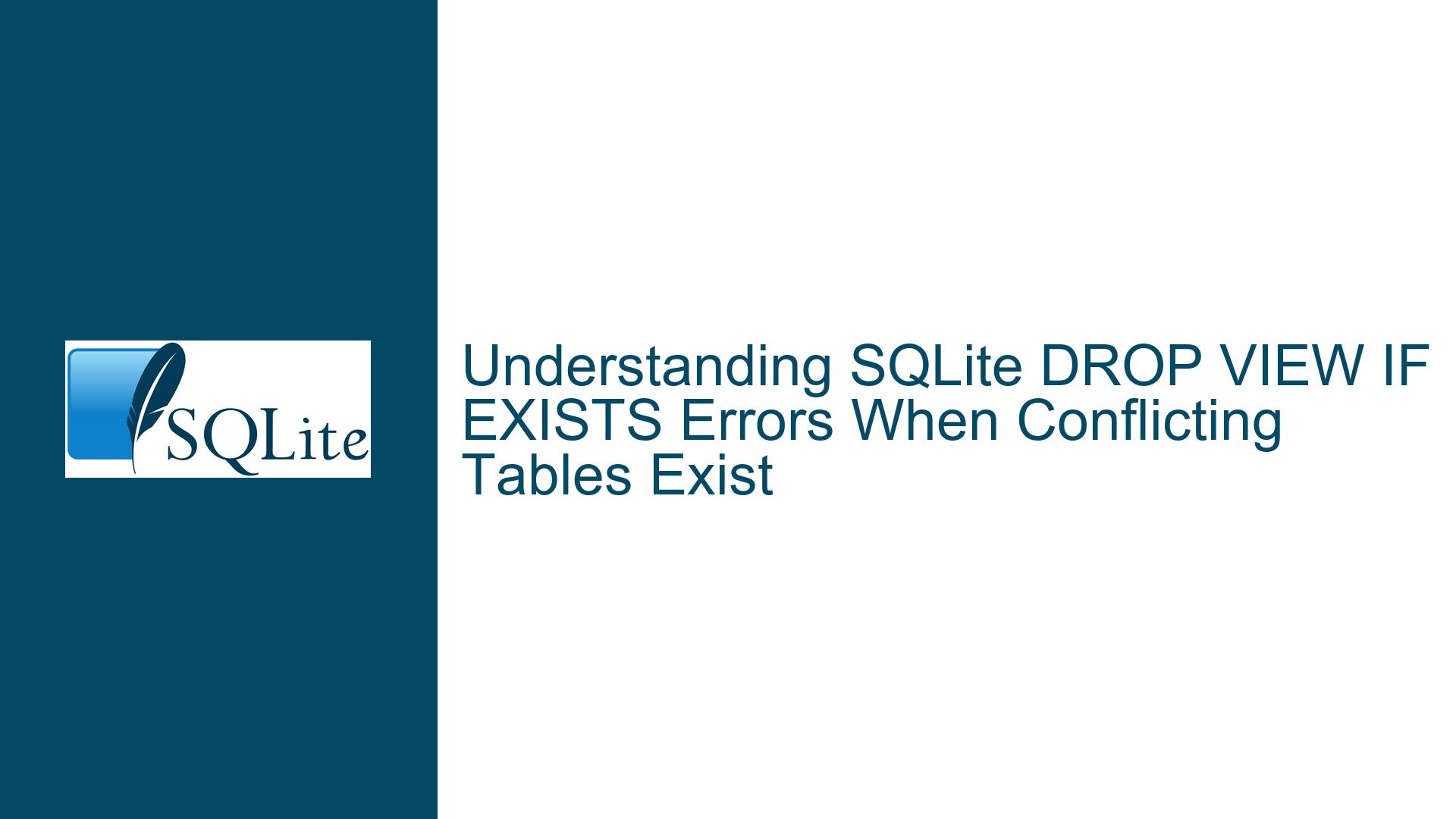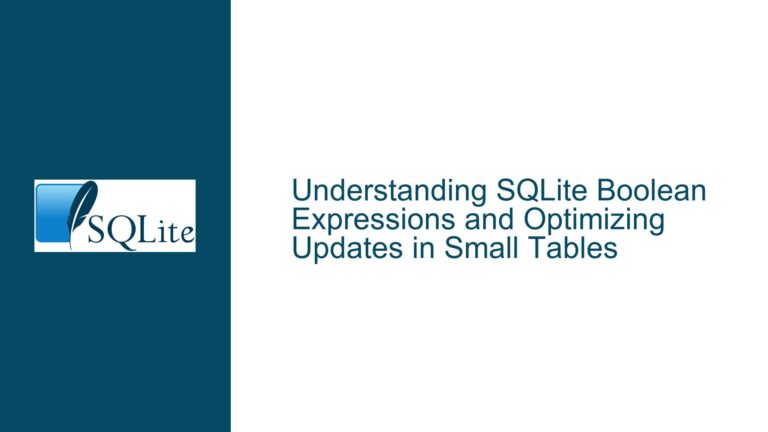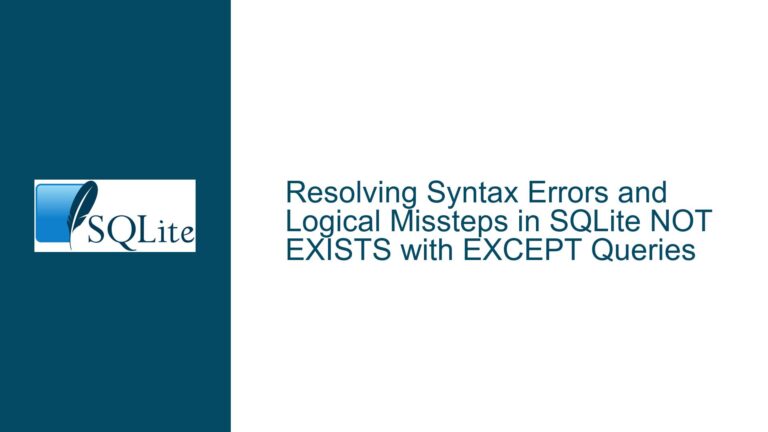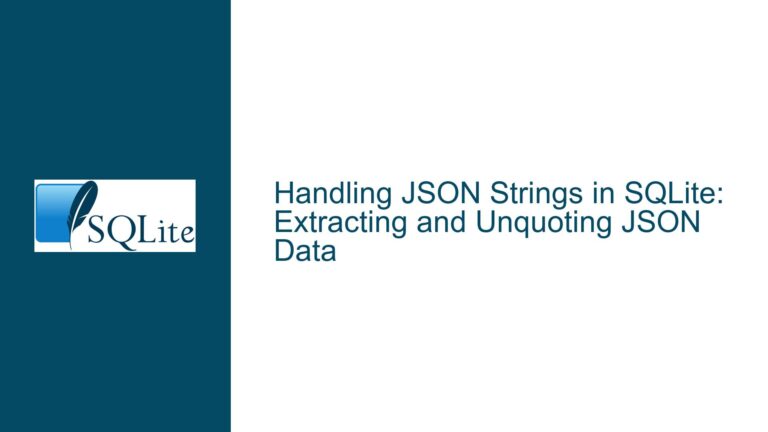SQLite DROP VIEW IF EXISTS Errors When Conflicting Tables Exist
Schema Object Type Mismatch in DROP VIEW IF EXISTS Statements
Issue Overview
The core issue arises when executing DROP VIEW IF EXISTS [object_name] in SQLite and encountering an error despite the absence of a view with the specified name. The error occurs when another schema object (e.g., a table) shares the same name as the view being dropped. For example:
CREATE TABLE a(b, c, d);
DROP VIEW IF EXISTS a; -- Fails with "Parse error: use DROP TABLE to delete table a"
Here, DROP VIEW IF EXISTS a attempts to remove a view named a, but since a is a table, SQLite raises an error. The user expects this command to execute silently (since no view exists), but SQLite instead generates an error due to the presence of a table with the same name. This behavior conflicts with intuition because IF EXISTS typically suppresses errors when the target object does not exist. However, SQLite’s implementation checks both the existence and the type of the schema object. If an object with the same name exists but is not a view, SQLite treats this as an error condition, even with IF EXISTS.
This behavior mirrors PostgreSQL’s handling of similar cases, where attempting to drop a view that shares a name with a table (or vice versa) results in an explicit error. SQLite’s adherence to strict schema object typing ensures that accidental data loss is avoided. For example, dropping a table when intending to drop a view (or vice versa) could lead to unintended consequences, and SQLite prioritizes preventing such scenarios.
Underlying Mechanics of Schema Object Validation
The root cause lies in how SQLite validates schema objects during DROP operations. When executing DROP VIEW IF EXISTS [name], SQLite performs the following steps:
- Schema Lookup: Checks the
sqlite_schema(formerlysqlite_master) table for an entry wheretype='view'andname=[name]. - Type Validation: If an entry with
name=[name]exists but has atypeother thanview, SQLite raises an error indicating a type mismatch. - Error Suppression: The
IF EXISTSclause suppresses errors only if no entry with the specified name exists in the schema, regardless of type.
Thus, the presence of a table named a triggers a type mismatch error because SQLite first confirms that an object named a exists but is not a view. The IF EXISTS clause does not suppress errors caused by type mismatches; it only suppresses errors when the object does not exist at all.
Practical Implications of the Error
This behavior impacts scenarios where schema management scripts or applications dynamically generate DROP statements. For example:
- Schema Migration Scripts: A script designed to replace a view with a table (or vice versa) might first attempt to drop the existing view. If the object is already a table, the script fails unless it explicitly checks the object type beforehand.
- Idempotent Deployments: Developers often write idempotent SQL scripts that can be rerun safely. A
DROP VIEW IF EXISTSfollowed byCREATE TABLE IF NOT EXISTSexpects theDROPto clear any prior view, but the presence of a table with the same name causes the script to fail.
Conflict Between Object Existence and Object Type Enforcement
Possible Causes
Strict Schema Object Typing:
SQLite enforces strict typing of schema objects (tables, views, indexes, triggers). TheDROPcommand requires the object type to match the operation (DROP TABLEfor tables,DROP VIEWfor views). Attempting to drop an object of the wrong type generates an error, even ifIF EXISTSis used. This prevents accidental deletion of objects due to naming conflicts.Ambiguity in
IF EXISTSSemantics:
TheIF EXISTSclause suppresses errors when the specified object does not exist. However, it does not suppress errors arising from type mismatches when an object exists but is of the wrong type. This ambiguity leads to confusion, as users expectIF EXISTSto ignore any non-matching objects entirely.Schema Lookup Logic:
SQLite’s schema lookup process prioritizes object existence over type validation. When executingDROP VIEW IF EXISTS a, the engine first checks if any object namedaexists. If it does, it then verifies whether the object is a view. If not, it raises an error, overriding theIF EXISTSclause.Cross-Platform Compatibility Expectations:
Users familiar with other databases (e.g., PostgreSQL) might expect SQLite to behave similarly, whereDROP VIEW IF EXISTSon a table also fails. However, differences in error messaging or handling can lead to unexpected results.
Resolving Type Mismatch Errors in DROP VIEW Operations
Troubleshooting Steps, Solutions & Fixes
1. Pre-Validation of Schema Object Types
Before executing DROP VIEW IF EXISTS, query the sqlite_schema table to determine if a view with the target name exists. If it does not, skip the DROP operation. This avoids triggering the type mismatch error.
SELECT COUNT(*) FROM sqlite_schema
WHERE type = 'view' AND name = 'a';
-- If result is 0, proceed without dropping
Application-Level Workaround:
In application code, use a conditional check to verify the object type:
cursor.execute("SELECT type FROM sqlite_schema WHERE name = 'a'")
row = cursor.fetchone()
if row and row[0] == 'view':
cursor.execute("DROP VIEW a")
2. Conditional DDL Using Procedural Logic
SQLite does not support procedural logic in standard SQL, but applications can implement this using a transaction block:
BEGIN TRANSACTION;
-- Check if a view named 'a' exists
SELECT 1 FROM sqlite_schema WHERE name = 'a' AND type = 'view';
-- If the above returns a row, execute:
DROP VIEW a;
COMMIT;
3. Unified Object Dropping with Type Handling
Create a helper function or script that drops an object regardless of its type by attempting both DROP TABLE and DROP VIEW:
DROP TABLE IF EXISTS a;
DROP VIEW IF EXISTS a;
Caution: This approach will drop a table if it exists, which may not be desirable. Use it only when the object type is uncertain, and dropping either is acceptable.
4. Schema Redesign to Avoid Naming Conflicts
Prevent naming conflicts between tables and views by adopting a naming convention that differentiates the two (e.g., prefixing views with v_):
CREATE TABLE data (id INTEGER);
CREATE VIEW v_data AS SELECT * FROM data;
-- Safe to drop without conflict
DROP VIEW IF EXISTS v_data;
5. Error Handling in Applications
Wrap DROP VIEW statements in a try-catch block to handle the error gracefully:
try:
cursor.execute("DROP VIEW IF EXISTS a")
except sqlite3.OperationalError as e:
if "use DROP TABLE" in str(e):
print("Warning: 'a' is a table, not a view.")
else:
raise
6. Modifying SQLite’s Behavior with Custom Extensions
For advanced users, SQLite’s C API allows creating custom functions or overriding the DROP command’s behavior. However, this requires significant expertise and is not recommended for most use cases.
7. Educating Users on SQLite’s Semantics
Document the behavior of DROP VIEW IF EXISTS to clarify that it errors on type mismatches, not just absent objects. This manages expectations and encourages proactive schema validation.
By understanding SQLite’s strict type enforcement and adopting proactive schema validation, developers can avoid errors when dropping views in the presence of same-named tables. Combining pre-validation checks, naming conventions, and application-level error handling ensures robust schema management.






